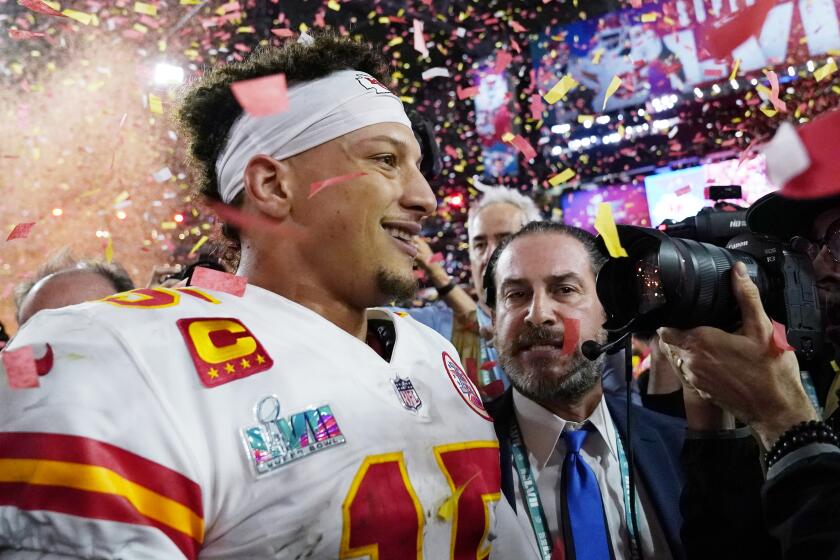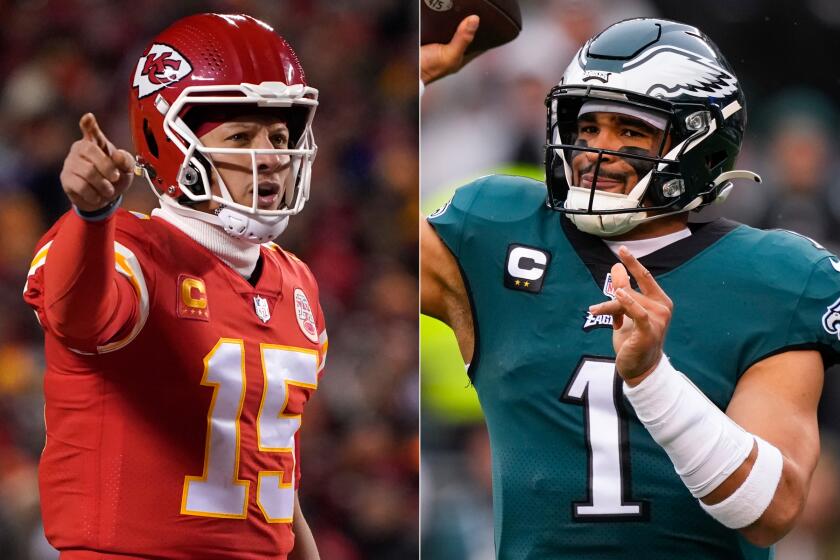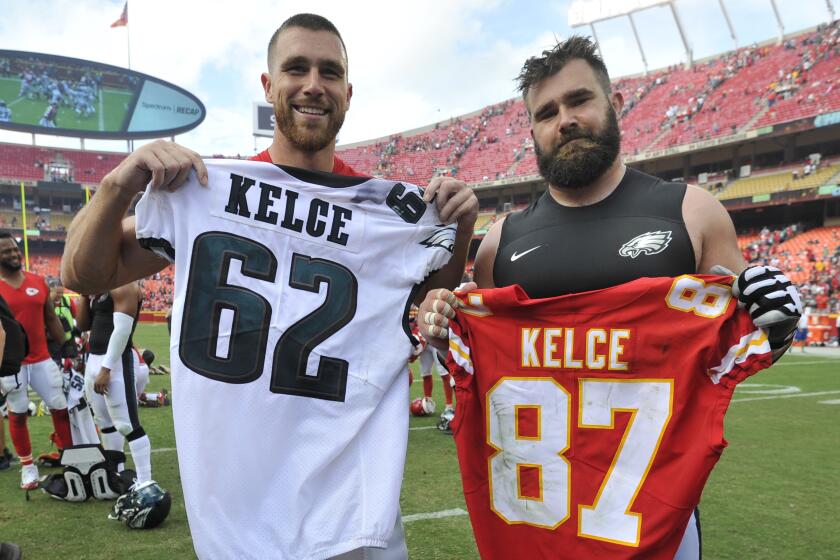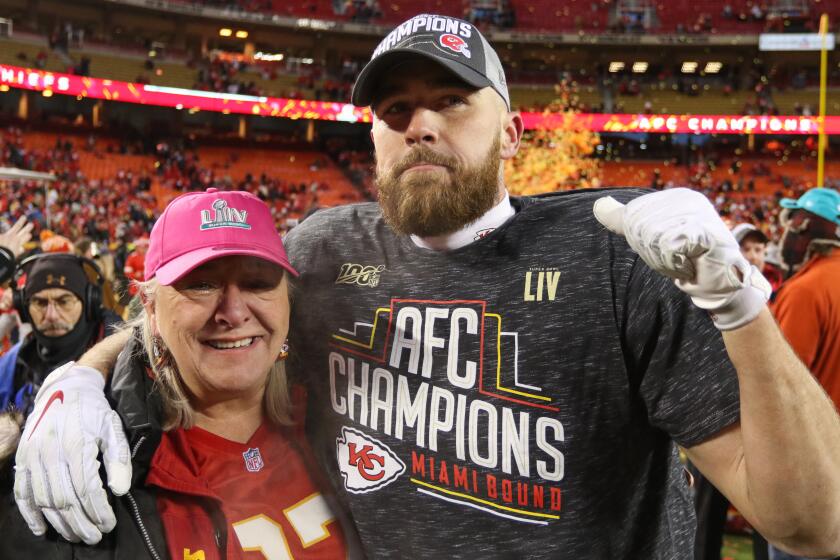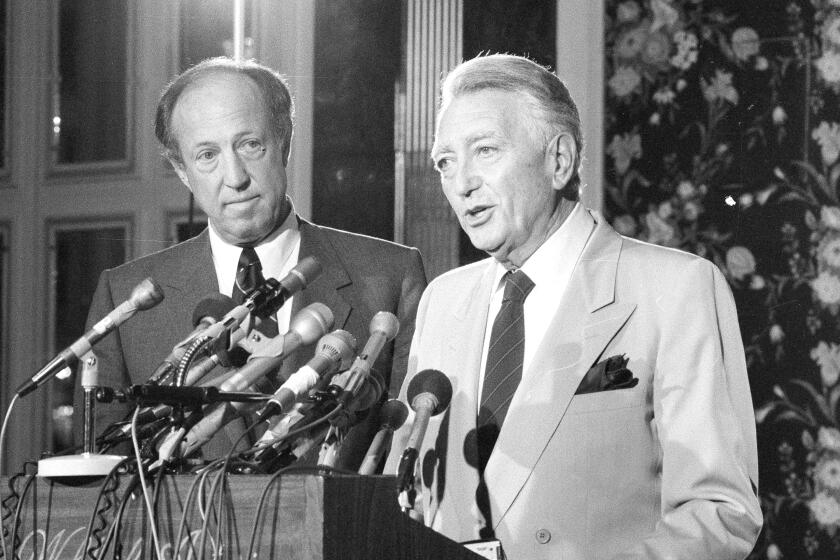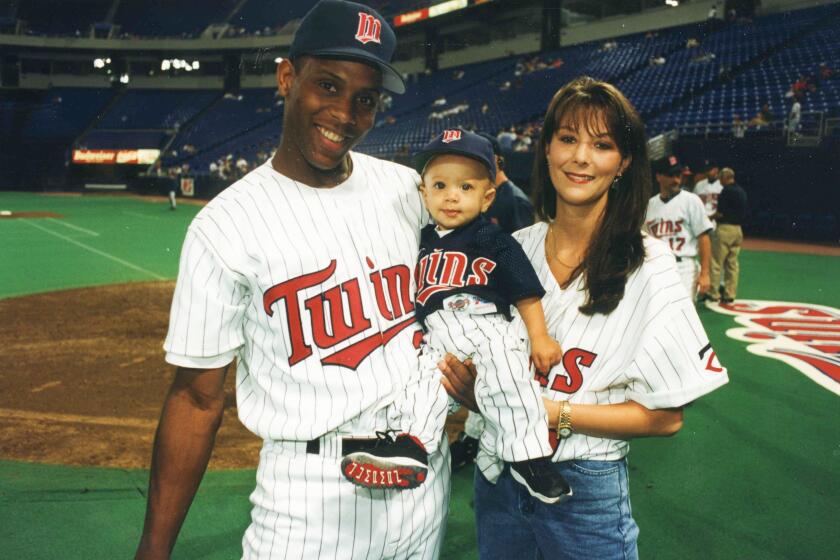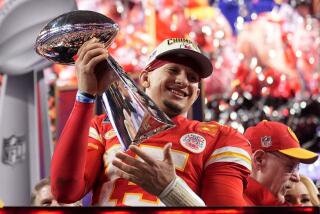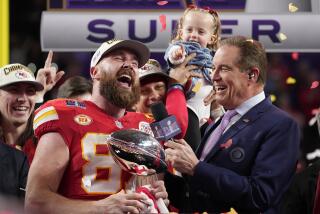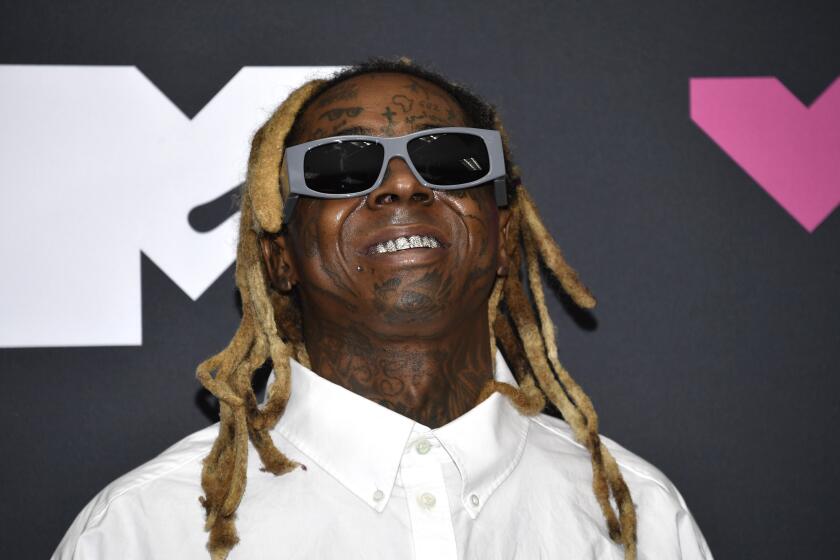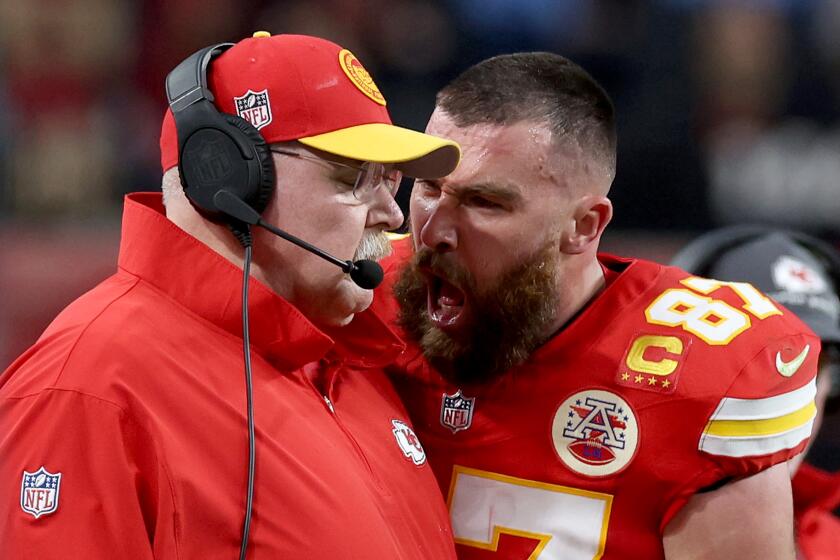Rams legend Jack Youngblood played through pain. That’s why he admires Patrick Mahomes
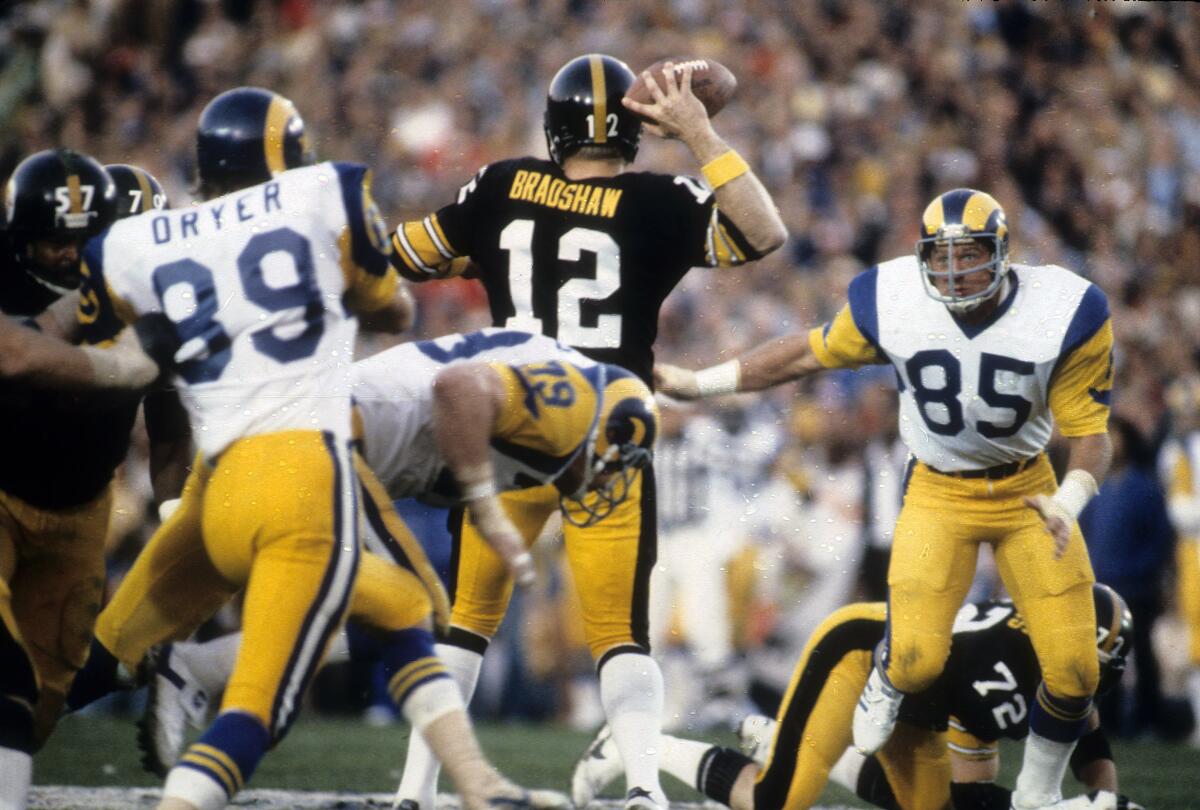
- Share via
PHOENIX — The ankle sprain was so severe that the pain covered a distance that could be measured in both miles and years.
The images of Patrick Mahomes traveled all the way from Kansas City, arriving on Jack Youngblood’s television down in Florida as a reminder of a similar scene more than four decades old.
“He was wound up on the sidelines,” Youngblood said. “Did you see him? He was going, ‘No, no, hell no!’ He’s like I was and still am — as hard-headed as a 7-year-old.”
Complete coverage of the Kansas City Chiefs’ win over the Philadelphia Eagles in Super Bowl LVII from Glendale, Ariz.
Mahomes’ animated response to being pulled from the Chiefs’ divisional round victory over Jacksonville last month punctuated how determined he was to push through his injury.
And he did return, missing only one series against the Jaguars and then playing every offensive snap in Kansas City’s AFC championship game win over Cincinnati, Mahomes limping badly at times but ultimately marching on.
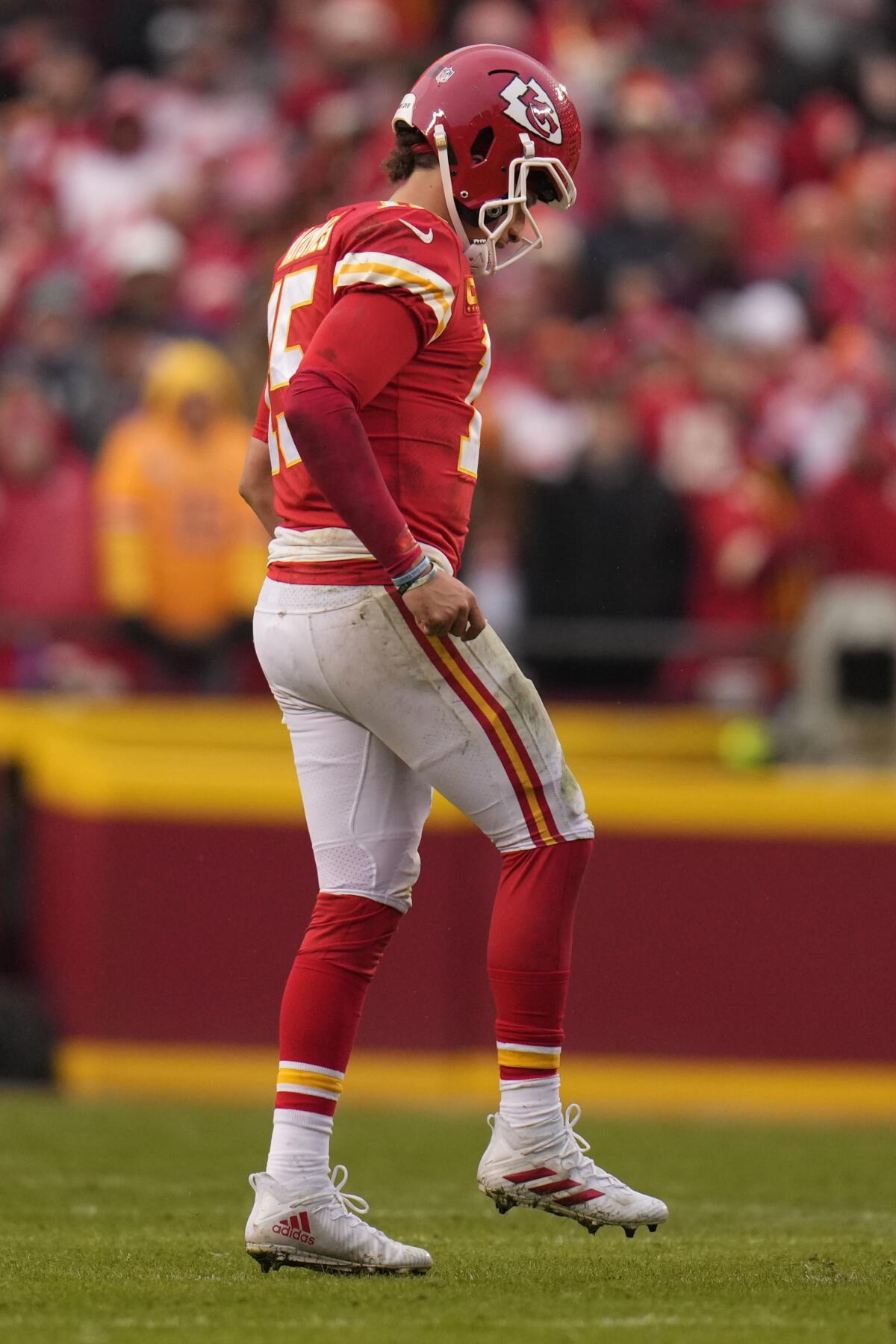
A high-ankle sprain couldn’t stop him any more than a broken tibia could thwart Youngblood during the 1979 playoffs, the former Rams defensive end playing 2½ games — including Super Bowl XIV — on a fractured leg.
“People to this day ask me about it,” Youngblood said. “I’ll see someone in the airport and it’s, ‘How the hell did you keep playing?’ These are people I don’t even know. I laugh and say, ‘I have no idea. I haven’t figured that one out yet.’ ”
In a league so committed to honoring tradition that its most important game still carries Roman numerals, the NFL has a notable history of players ignoring injuries to participate in the Super Bowl.
Among so many others, Carolina linebacker Thomas Davis had a broken arm, Philadelphia wide receiver Terrell Owens a broken leg and and torn ankle ligament, and New England quarterback Tom Brady a lacerated hand.
New York Giants wide receiver Plaxico Burress caught the winning touchdown in the final minute of Super Bowl XLII despite two bad ankles, a separated shoulder, a torn pinky ligament and a sprained knee.
“I’m so proud of that child. His fortitude. His determination. His leadership. His spirit.”
— Rams legend Jack Youngblood, on Patrick Mahomes and his ankle injury
“That’s the ultimate game,” Dwight Freeney said. “If I can walk a little bit and my coaches let me play, I’m playing. That’s just what it is. That’s the kind of mentality guys have. It’s that big of a moment.”
So Freeney played, too, the former Indianapolis pass rusher even recording a sack in Super Bowl XLIV on an ankle sprain he now describes as “absolutely terrible.”
On Sunday, Mahomes won’t be alone in trying to manage his ailing body through — at least — four more quarters. There will be plenty of others, including Philadelphia’s Lane Johnson.
Here’s everything you need to know about the 2023 Super Bowl, including start time, location, TV channel, streaming options and the halftime show.
The All-Pro right tackle on Christmas Eve suffered a torn adductor (groin) injury significant enough to require surgery. When Johnson learned of the severity, Eagles offensive line coach Jeff Stoutland said the 10-year veteran cried.
But Johnson stiff-armed the operation in favor of resting and rehabbing to the point where he could return for the playoffs.
“I knew we had a talented team and a chance to be a great team,” he said this week. “As you get older and your career goes down the line, your opportunities get limited. I knew I had to try to seize this chance.”
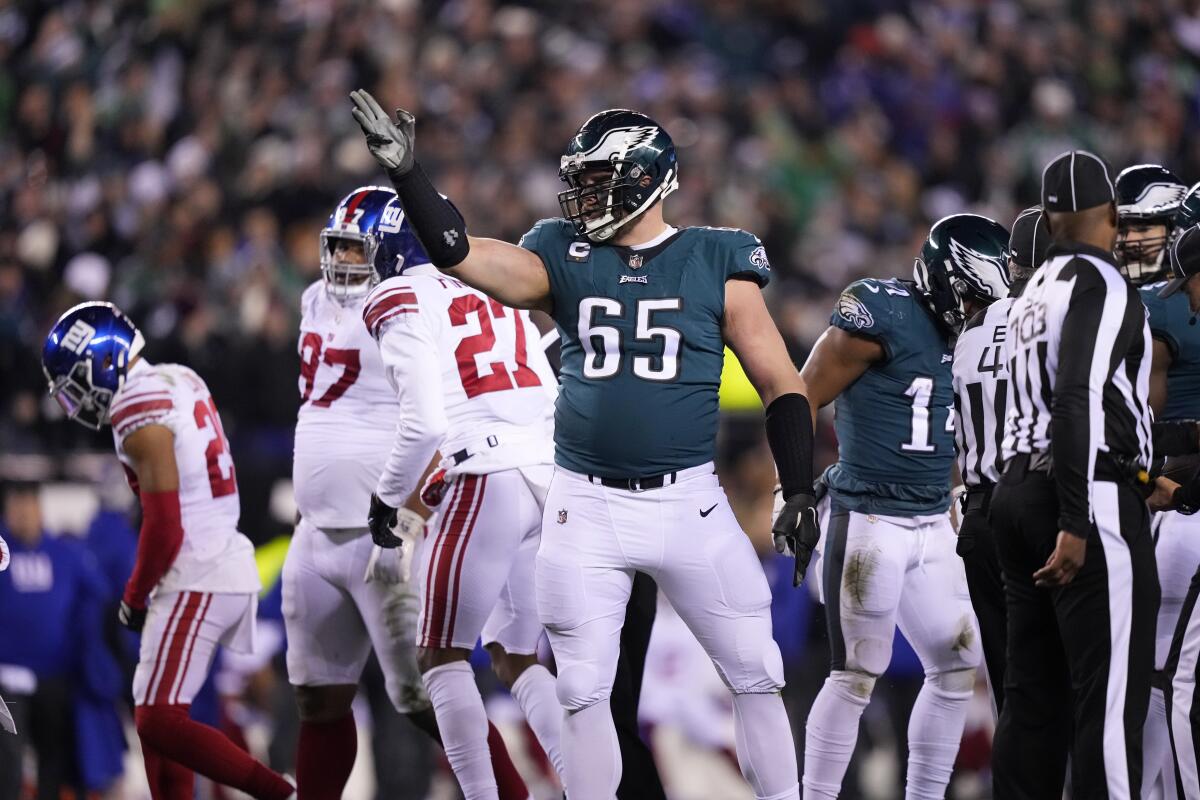
Understanding pain management first requires understanding pain, something Dr. Vernon Williams does better than most as the founding director of the Center for Sports Neurology and Pain Medicine at Cedars-Sinai Kerlan-Jobe Institute.
He explained that areas of injury transmit electrical signals via the nervous system through the spinal cord to the brain. It is the brain that then produces pain, typically as a defense response to protect the body.
But the amount of pain experienced can be influenced by much more than just the player’s injury. There is everything that’s happening around the player to consider as well.
“It’s a real and interesting phenomenon,” Williams said. “The thing to remember is there’s not a one-to-one relationship between tissue damage or tissue injury and the amount of pain a person feels.
“Pain is individual, and it’s informed by a lot of things like emotional context and the environment. That’s why we can see some of these extraordinary feats where you go, ‘How is this possible?’ ”
Travis and Jason Kelce are on opposing sides for the Chiefs and Eagles in the 2023 Super Bowl, and their father understands their competitive nature.
Playing on his broken leg, Youngblood recalled feeling pain in the huddle and walking around before the ball was snapped. He said the sensation suddenly disappeared the moment he reached the line of scrimmage and placed his hand on the ground.
Calling it “kind of shocking,” Youngblood said he soon realized there was a mental aspect to something otherwise completely physical as he and his teammates chased what would have been the Rams’ first Super Bowl win.
Williams explained that Youngblood was experiencing the impact of his surroundings, surroundings as significant as any an NFL player can encounter.
“The situation might be such that the motivation is so strong, the emotional environment so tipped in the direction of ‘I must perform’ that one can manage and overcome those electrical signals,” he said.
Watching their sons play against one another in the NFL can be an ‘emotional teeter-totter’ for parents who want their children to win.
“It’s really the emotional context that those signals arrive at in the brain as to whether there’s incapacitating pain, moderate pain or there’s pain, yes, but pain where one can overcome and continue to perform.
“I can tell you, the scenario is going to be different if it’s an injury in practice on a team that’s not going to make it to the playoffs compared to a team that’s heading to the Super Bowl.”
Though Youngblood retired nearly 40 years ago, his remains the most famous of the NFL’s broken-body Super Bowl tales. He was hurt late in the first half of the Rams’ divisional round win at Dallas.
Upon retreating to the locker room, Youngblood said X-rays were taken before he consulted with longtime Rams physician Clarence Shields.
“Dr. Shields sticks the picture in the light board and says, ‘See right there. You broke the tibia,’ ” Youngblood recalled. “I said, ‘Yeah, Clarence, I can see that. Now, tape the damn thing up. We got 30 minutes to win this ballgame.’ ”
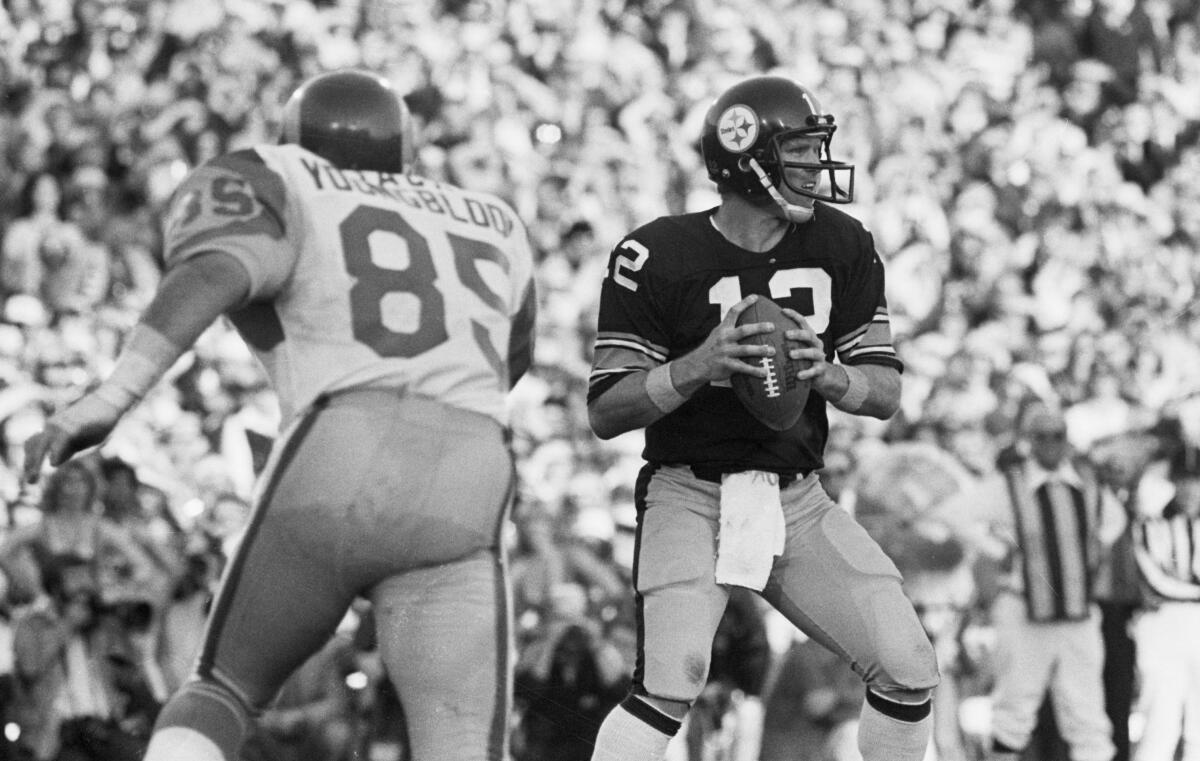
Estimating that he was at 90% physically, Youngblood finished the game against the Cowboys and then helped the Rams shut out Tampa Bay 9-0 for the NFC championship.
He wore an extra plastic pad to protect his leg during games and barely practiced. Youngblood said he took “several injections to try to keep the swelling down” and was administered aspirin.
“OK,” he said, laughing, “maybe it was a little stronger than aspirin.”
Against Pittsburgh in Super Bowl XIV, the Rams took a lead into the fourth quarter before falling 31-19 at the Rose Bowl.
Long before advancing to the Super Bowl in Arizona to play the Kansas City Chiefs, the Philadelphia Eagles were close to calling Phoenix their new home.
Youngblood said the motivation of playing for a title certainly drove him — but not as much as playing for his teammates did.
“I loved my team,” he said. “On top of that, I was a captain. I was the leader of the defense. Playing was my responsibility. I had to give every ounce of energy and determination that I could put on that field for 60 minutes.”
And his determination didn’t stop there. A week after the Super Bowl, Youngblood and his fractured tibia showed up in Hawaii to participate in the Pro Bowl, an exhibition that lacked significance but offered opportunity.
When one of the NFC coaches saw Youngblood, he questioned why the injured seven-time Pro Bowler was even at the event.
Pat Mahomes, former MLB pitcher and father of Chiefs QB Patrick Mahomes, told his son to quit football, thinking his future was in baseball or basketball.
“I told him, ‘I just played 19 ballgames. You think I’m gonna miss this party?’ ” Youngblood said, laughing again. “He looked at me like I was either sick or crazy.”
So, all these years later, Youngblood is readying to watch another set of players grit their way through the NFL’s ultimate game, the group including Kansas City’s star quarterback.
Known for this ability to escape defenders, Mahomes now also is proving he can be quite adept at eluding pain.
“I’m so proud of that child,” Youngblood said. “His fortitude. His determination. His leadership. His spirit. I mean, every time he snaps that ball, he wants to win, no matter how he’s feeling. I admire that, tremendously.”
More to Read
Go beyond the scoreboard
Get the latest on L.A.'s teams in the daily Sports Report newsletter.
You may occasionally receive promotional content from the Los Angeles Times.

